
Nov 27
/
Alef Dias
Grains, Oilseeds and Livestock Weekly Report - 2023 11 27
Back to main blog page
"Although it's only the beginning of the season, the severe delay in planting and the poor crop conditions in France could already have an irreversible impact on the results of the EU's main producer.
The heavy rains that have fallen in the country in recent weeks have brought wheat sowing to a virtual standstill. France recorded its highest level of rainfall ever for 26 consecutive days, with 215.4 mm between October 18 and November 12. As of last week, French producers had only planted 74% of the expected area vs 98% last year.
Given the much more favorable situation observed in the Black Sea and US crops, this scenario should contribute to the continuation throughout the 24/25 harvest of two trends observed in the second semester: weak French and EU exports due to low competitiveness against Russian wheat; and a strengthening of Euronext wheat vs Chicago."
Wheat: Impact of delayed planting in France
Introduction
With the dormancy period for the 24/25 winter wheat crop approaching in the main producing countries of the Northern Hemisphere, planting data and conditions in these regions are becoming increasingly relevant.
Among these countries, France certainly has the most worrying situation so far. Farmers in the European Union's (EU) main producing country are facing difficulties in planting the 24/25 crop, which could have a significant impact on the wheat markets in the coming months.
Fig. 1: Crop Progress - France (%)
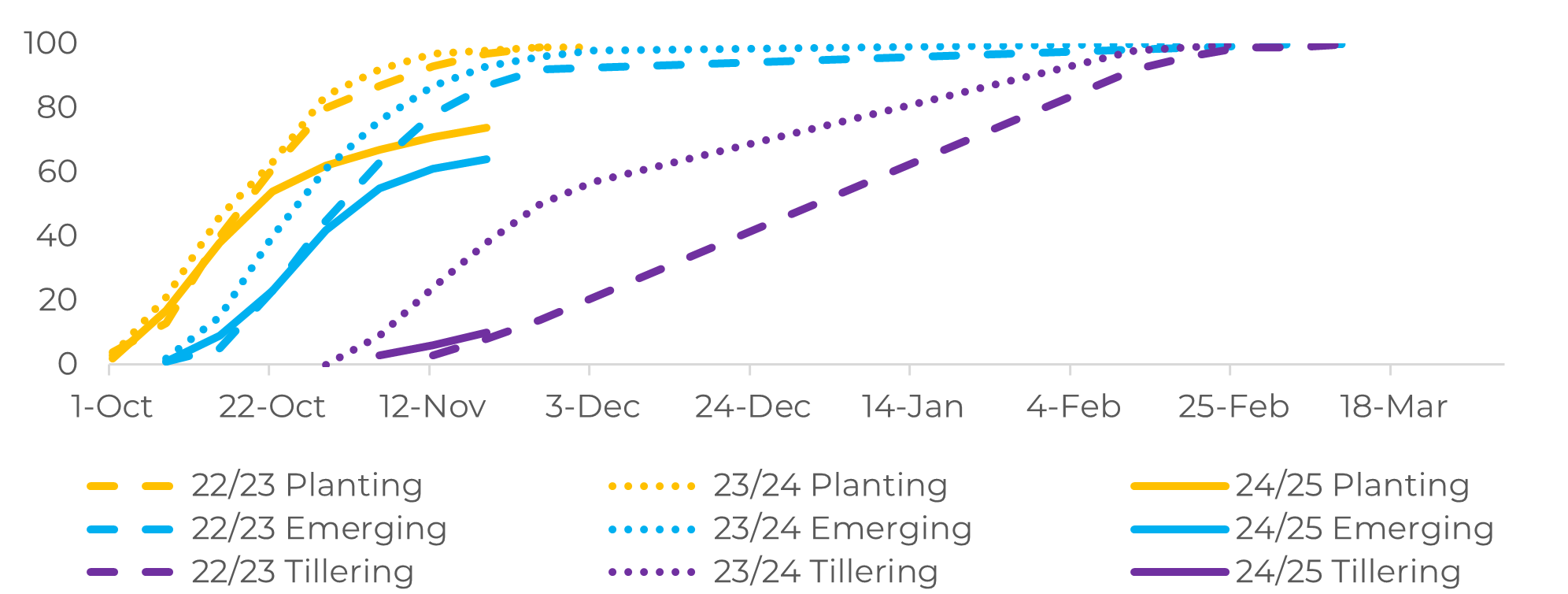
Source: CME
Fig. 2: Accumulated Precipitation - Last 60 days (mm)
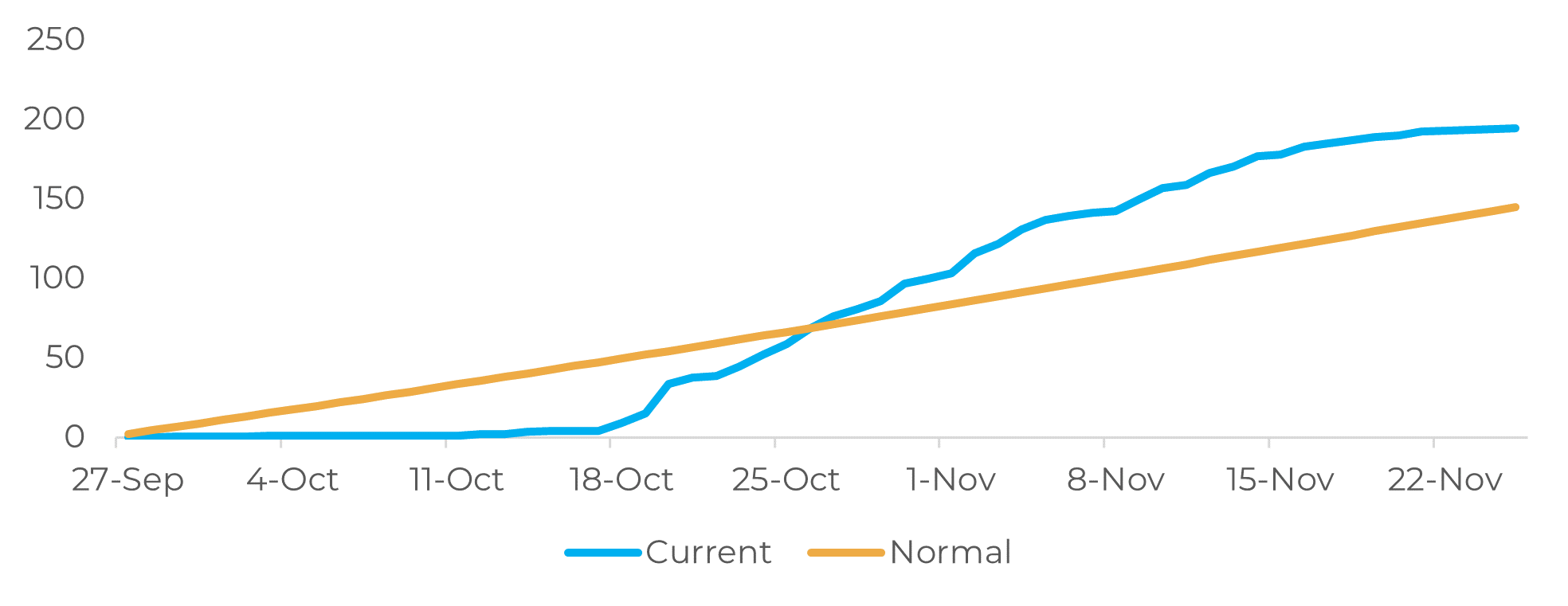
Source: Safras
Heavy rains lead to severe planting delays
The heavy rains that have fallen in France in recent weeks have brought wheat sowing to a virtual standstill. Farmers benefited from very favorable sowing conditions at the start of the season, but France recorded its highest level of rainfall ever for 26 consecutive days, with 215.4 mm between October 18 and November 12.
According to the French Ministry of Agriculture, French producers had sown 74% of the soft wheat area expected for next year's harvest by November 20, compared to 71% a week earlier. At the same time last year, planting was almost 98% complete.
In addition to the delay in planting, the heavy rains have also had an impact on the conditions of the crop. The amount of soft wheat in good or excellent condition stood at 83%, down from 86% last week. In the same period in the last two harvests - 23/24 and 22/23 - 98% and 99% of the crop was in good and excellent condition, respectively.
Fig. 3: Crop conditions - France (%)
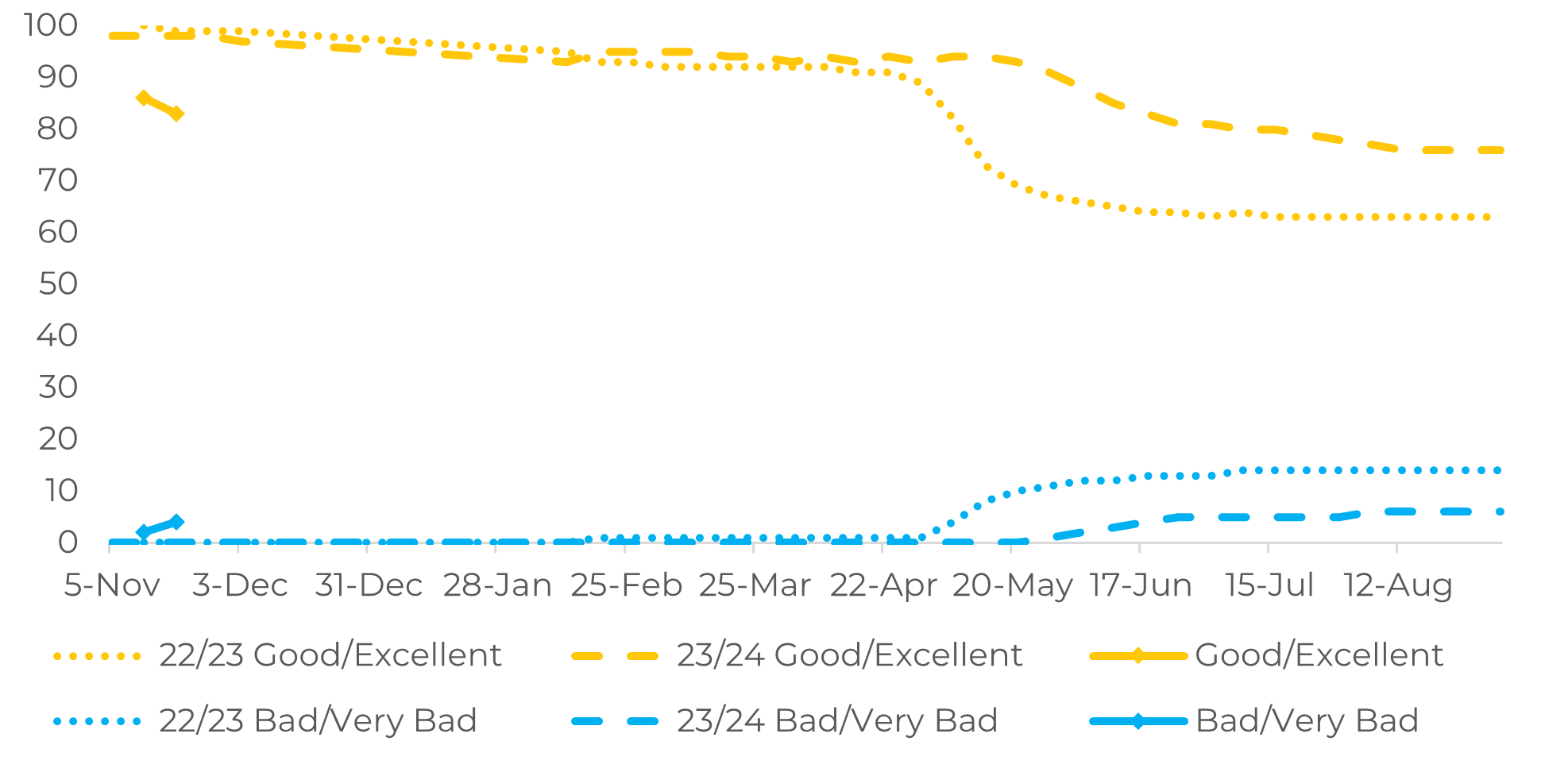
Source: CME, NYMEX
Fig. 4: Soil Moisture - France (% in 1m of soil)
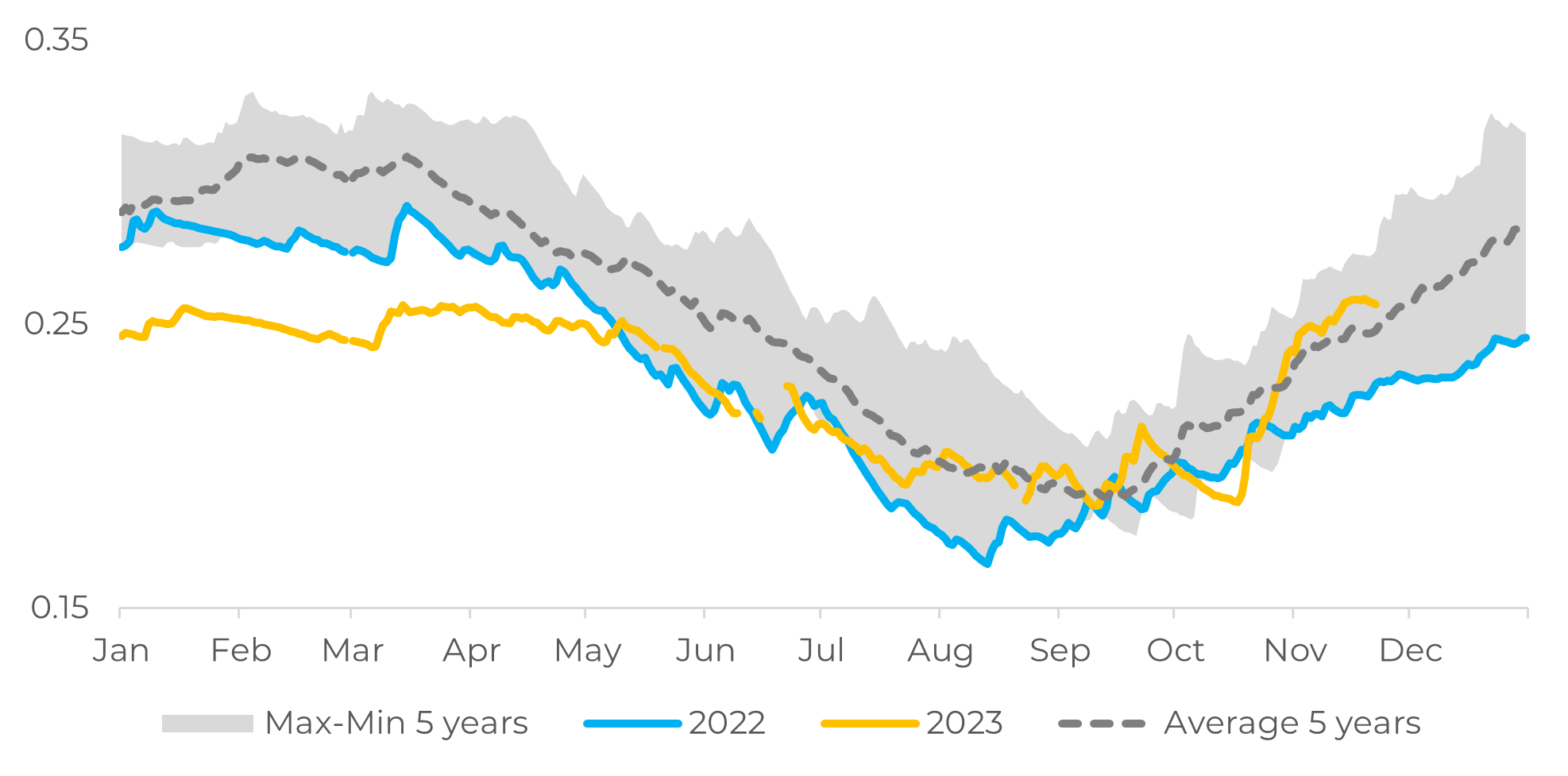
Source: EPA
The situation should lead to lower area and productivity
The expectation at the start of the harvest was already of a reduction in the area planted in the EU, mainly due to the low price scenario, but the delay in planting should lead to an even greater cut, given that the "ideal" planting window is practically over.
In addition to the smaller seeded area, yield should also be affected. Planting during the ideal period allows the wheat to form a sufficient, but not excessive, number of tillers. Early sowing results in an excessive number of tillers in the fall, which can compete with each other, become diseased, and deplete the soil's moisture, causing grain yields to be low. Late sowing gives the plants little time to develop tillers, resulting in an inadequate number of ears (heads) for a high yield the following spring.
Fig. 5: Soft Wheat Exports - France (M mt)
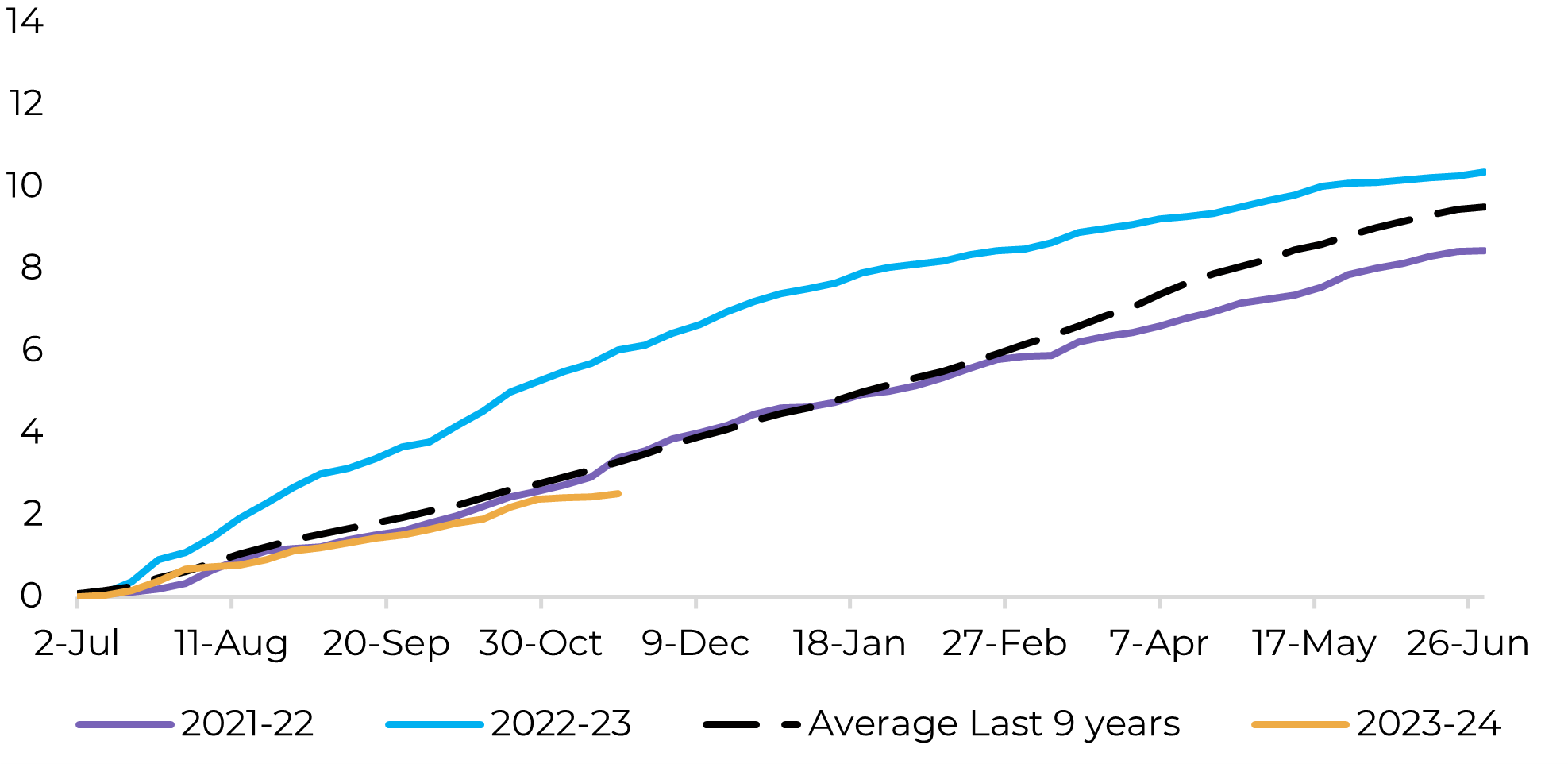
Source: CME, NYMEX
Fig. 6: Euronext-Chicago Wheat Spread (USD/mt)
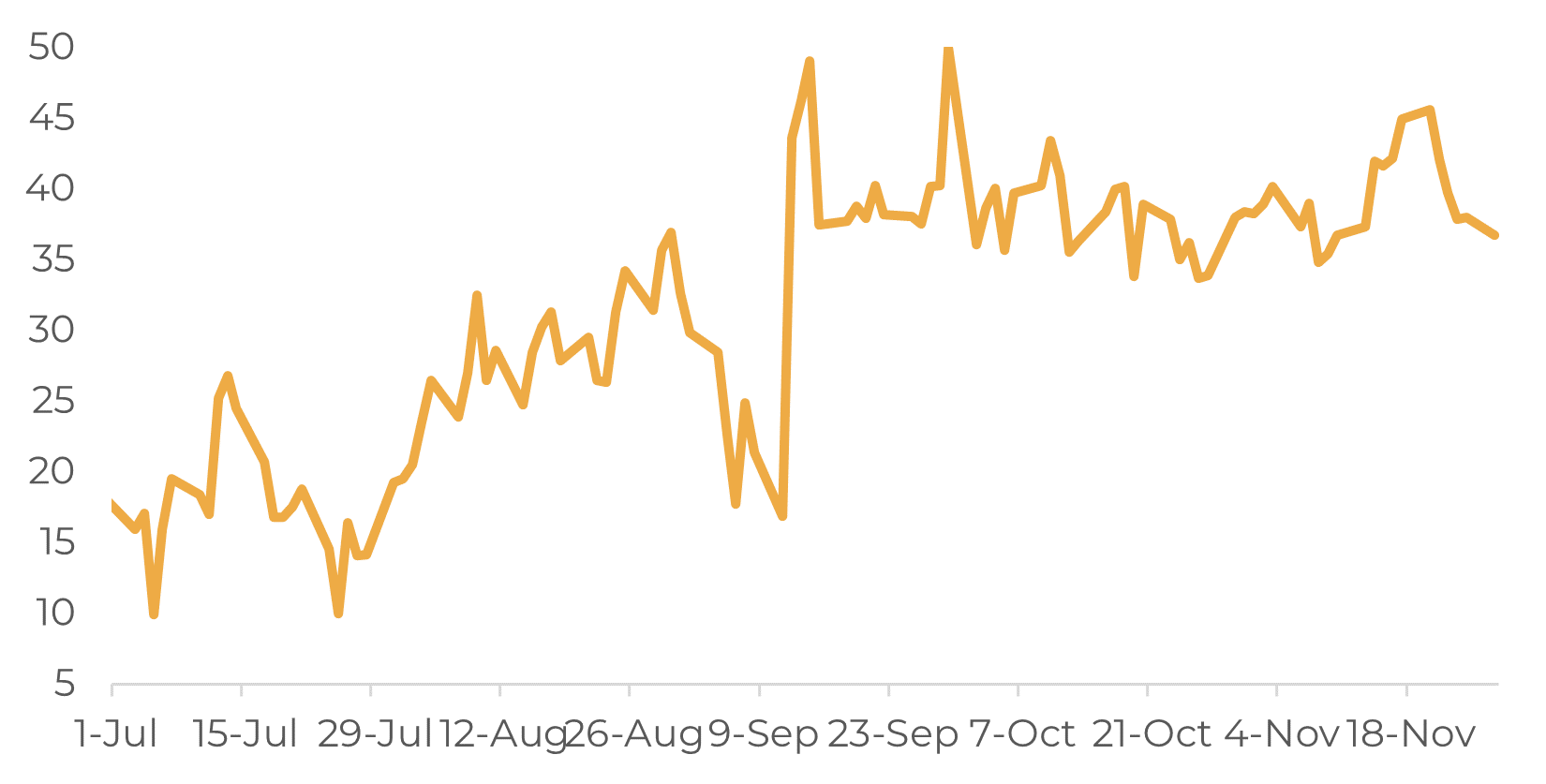
Source: EPA
Conclusions
Although it's only the beginning of the crop, the severe delay in planting in France could already have irreversible impacts on the results of the EU's main producer - around 28% on average over the last few crops. First unofficial estimates point to a reduction of up to 8M mt in the bloc's harvest, given that Germany is also facing a similar situation.
Given the more favorable situation observed in the Black Sea crops (Ukraine and Russia) and in the US, this scenario should contribute to the continuation throughout the 24/25 harvest of two trends observed in the second semester: weak French and EU exports due to low competitiveness against Russian wheat; and a strengthening of Euronext wheat against Chicago.
Weekly Report — Grains and Oilseeds
Written by Alef Dias
alef.dias@hedgepointglobal.com
alef.dias@hedgepointglobal.com
Reviewed by Pedro Schicchi
pedro.schicchi@hedgepointglobal.com
pedro.schicchi@hedgepointglobal.com
www.hedgepointglobal.com
Disclaimer
This document has been prepared by hEDGEpoint Global Markets LLC and its affiliates ("HPGM") exclusively for informational and instructional purposes, without the purpose of creating obligations or commitments with third parties, and is not intended to promote an offer, or solicitation of an offer, to sell or buy any securities or investment products. HPGM and its associates expressly disclaim any use of the information contained herein that may result in direct or indirect damage of any kind. If you have any questions that are not resolved in the first instance of contact with the client (client.services@hedgepointglobal.com), please contact our internal ombudsman channel (ouvidoria@hedgepointglobal.com) or 0800-878-8408 (for clients in Brazil only).
Contact us
hedgepointhub.support@hedgepointglobal.com
ouvidoria@hedgepointglobal.com
Funchal Street, 418, 18º floor - Vila Olímpia São Paulo, SP, Brasil
Check our general terms and important notices.
This page has been prepared by Hedgepoint Schweiz AG and its affiliates (“Hedgepoint”) solely for informational and instructional purposes, without the purpose of instituting obligations or commitments to third parties, nor is it intended to promote an offer, or solicitation of an offer of sale or purchase relating to any securities, commodities interests or investment products. Hedgepoint and its associates expressly disclaim any use of the information contained herein that directly or indirectly result in damages or damages of any kind. Information is obtained from sources which we believe to be reliable, but we do not warrant or guarantee the timeliness or accuracy of this information. The trading of commodities interests such as futures, options, and swaps involves substantial risk of loss and may not be suitable for all investors. You should carefully consider wither such trading is suitable for you in light of your financial condition. Past performance is not necessarily indicative of future results. Customers should rely on their own independent judgement and/or advisors before entering in any transaction.Hedgepoint does not provide legal, tax or accounting advice and you are responsible for seeking any such advice separately.Hedgepoint Schweiz AG is organized, incorporated, and existing under the laws of Switzerland, is filiated to ARIF, the Association Romande des Intermédiaires Financiers, which is a FINMA-authorized Self-Regulatory Organization. Hedgepoint Commodities LLC is organized, incorporated, and existing under the laws of the USA, and is authorized and regulated by the Commodity Futures Trading Commission (CFTC) and a member of the National Futures Association (NFA) to act as an Introducing Broker and Commodity Trading Advisor. HedgePoint Global Markets Limited is Regulated by the Dubai Financial Services Authority. The content is directed at Professional Clients and not Retail Clients. Hedgepoint Global Markets PTE. Ltd is organized, incorporated, and existing under the laws of Singapore, exempted from obtaining a financial services license as per the Second Schedule of the Securities and Futures (Licensing and Conduct of Business) Act, by the Monetary Authority of Singapore (MAS). Hedgepoint Global Markets DTVM Ltda. is authorized and regulated in Brazil by the Central Bank of Brazil (BCB) and the Brazilian Securities Commission (CVM). Hedgepoint Serviços Ltda. is organized, incorporated, and existing under the laws of Brazil. Hedgepoint Global Markets S.A. is organized, incorporated, and existing under the laws of Uruguay. In case of questions not resolved by the first instance of customer contact (client.services@Hedgepointglobal.com), please contact internal ombudsman channel (ombudsman@hedgepointglobal.com – global or ouvidoria@hedgepointglobal.com – Brazil only) or call 0800-8788408 (Brazil only).Integrity, ethics, and transparency are values that guide our culture. To further strengthen our practices, Hedgepoint has a whistleblower channel for employees and third-parties by e-mail ethicline@hedgepointglobal.com or forms Ethic Line – Hedgepoint Global Markets.Security note: All contacts with customers and partners are conducted exclusively through our domain @hedgepointglobal.com. Do not accept any information, bills, statements or requests from different domains and pay special attention to any variations in letters or spelling, as they may indicate a fraudulent situation.“HedgePoint” and the “HedgePoint” logo are marks for the exclusive use of HedgePoint and/or its affiliates. Use or reproduction is prohibited, unless expressly authorized by HedgePoint. Furthermore, the use of any other marks in this document has been authorized for identification purposes only. It does not, therefore, imply any rights of HedgePoint in these marks or imply endorsement, association or seal by the owners of these marks with HedgePoint or its affiliates.
We have updated our Terms & Conditions to reflect improvements to our platform, data handling practices, and the overall experience we provide to our clients.
To continue using the Hedgepoint HUB, please review and accept the updated terms.

